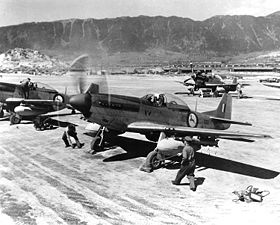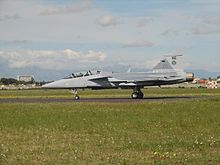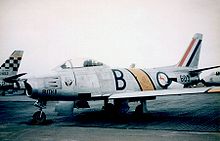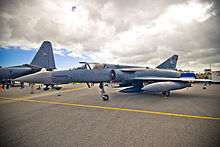- 2 Squadron SAAF
-
2 Squadron 
2 Squadron Mustang fighters during the Korean WarActive 1 October 1940 to current[1] Country  South Africa
South AfricaBranch  South African Air Force
South African Air ForceRole Attack/Interception Garrison/HQ AFB Makhado Nickname Flying Cheetahs Motto Latin: Sursam Prorsusque
("Upward and Onward")Mascot Historically, two cheetah cubs Equipment JAS 39 Gripen Decorations  United States Presidential Unit Citation
United States Presidential Unit Citation
Battle honours East Africa 1941
The Juba & The Lakes; Western Desert 1941–1943
Sidi Rezegh
Agedabia
Gazala
El Alamein; French North Africa 1943
El Hamma & Tunis
Mediterranean 1943
South East Europe 1944–1945
Italy 1943–1945, The Sangro & Gothic Line
Korea 1950–1953, Pjong-JangInsignia Squadron Identification Code DB (1939-1945)[2] 2 Squadron is a squadron in the South African Air Force which was formed in 1940.[1][3]
Contents
Background
2 Squadron is currently the premier squadron in the South African Air Force, and has a long history, having been involved in every single combat action in which the SAAF has taken part. During the Second World War it made a name for itself in the battles for East Africa, before distinguishing itself in North Africa as part of the Desert Air Force, and later in Italy.
History
Second World War
During the initial years of the war, 2 Squadron served as part of 1 Bomber Brigade in the East African Campaign as well as the North African Campaign. After August 1943, they also saw action in Sicily, Italy and Yugoslavia.[3]
Korean War
The squadron was South Africa's contribution to the United Nations war effort during the Korean War from November 1950 to December 1953. 2 Squadron was attached to USAF 18th Fighter-Bomber Wing for the duration of the war.[4] Initially flying the P-51 Mustang, the squadron re-equipped with the F-86 Sabre in February 1953. During the war the squadron flew a total of 12 067 sorties, most being dangerous ground attack missions. 74 of the 94 Mustangs and 4 out of the 22 Sabres were lost, along with 34 pilots.
For their actions, the squadron received the Republic of Korea Presidential Unit Citation and United States Presidential Unit Citation, along with numerous other awards and decorations.
In addition, the Commanding Officer of the USAF's 18th FBW, to which the squadron was assigned, issued a directive at the end of the war that:
In memory of our gallant South African comrades, it is hereby established, as a new policy that at all Retreat Ceremonies held by this Wing, the playing of our National Anthem shall be preceded by playing the introductory bars of the South African National Anthem, 'Die Stem van Suid-Afrika'. All personnel of this Wing will render the same honours to this Anthem as our own.South African Border War
The squadron also played a vital role during the South-West Africa/Angola Border War.
Till 2 April 2008 the squadron operated the Cheetah C\D fighter aircraft and was equipped with 28 examples. The squadron flew 1010 hours in 2004.[5]
Current status
 The squadron's current fighter, the JAS 39 Gripen.
The squadron's current fighter, the JAS 39 Gripen.
Conversion to the new Mirage III occurred in 1963 and the squadron moved to AFB Hoedspruit at the end of 1978. They continued to fly the Mirages until October 1990. They later re-equipped with the Atlas Cheetah C and D, but remained 'on the books' during the hiatus between Mirage and Cheetah, not being officially disbanded at that point. Reconnaissance was also performed using Vinten Vicon 18 Series 601 pod. Regular night flying was performed and the aircrew also performed air to air refueling operations with the Boeing 707 aircraft of 60 Squadron, until these were retired in 2007. The squadron participates in the annual SANDF force preparation exercises which includes using live weapons. During joint exercises with the German Luftwaffe in 2006, 40 live V3S "Snake" short range air to air missiles were fired at the Denel Overberg Test Range.[6]
Moving to Louis Trichardt (now AFB Makhado) in January 1993, 2 Squadron became the sole front line combat jet squadron in the SAAF.
The last of the Cheetahs were retired on 2 April 2008, latet tha month the first new JAS 39 Gripen arrived. The SAAF accepted its first Gripen D in April 2008 and the final two Gripen D aircraft arrived in South Africa in July 2009. The first two Gripen Cs arrived on 11 February 2010 with deliveries ongoing as at October 2011. The squadron operates all the SAAF's Gripens except for the first Gripen D, which is assigned to the Test Flight and Development Centre at AFB Overberg.
Aircraft previously operated
- Hawker Hartebees
- Hawker Fury I[7]
- Gloster Gauntlet
- Gloster Gladiator II
- Hawker Hurricane
- Tomahawk IIIB June 1941 - May 1942
- Kittyhawk I April 1942 - June 1943
- Kittyhawk III June 1943 - July 1943
- Supermarine Spitfire Vc July 1943 - March 1944
- Supermarine Spitfire IX February 1944 - July 1945
- North American F-51D Mustang July 1945 - 1953
- North American F-86F Sabre 1953
- de Havilland Vampire 1953-56
- Canadair Sabre Mk.6 1956-63
- Dassault Mirage III 1963-88
- Atlas Cheetah C and D 1988-2008
- JAS 39 Gripen 2008–present
See also
Further reading
- Brent, W.A.. Flying Cheetahs 1950-1953. Freeworld Publications. ISBN 978-0-9583880-9-2.
References
Notes
- ^ a b "THE SQUADRONS INCEPTION". South African Air Force. Archived from the original on 2009-07-22. http://www.af.mil.za/bases/afb_makhado/2sqn.htm#Historic%20Overview. Retrieved 2009-07-18.
- ^ Martin, H.J. Lt-Gen; Orpen, N.D. (1978). Eagles Victorius: South African Forces World War II. Cape Town: Purnell. pp. 14c. ISBN 0-86843-008-0.
- ^ a b "Squadron 2". GlobalSecurity.org. http://www.globalsecurity.org/military/world/rsa/sqn-2.htm. Retrieved 2009-07-18.
- ^ McGregor, P. M. J. (June 1978-06-03). "The History of No 2 Squadron, SAAF, in the Korean War". Military History Journal (The South African Military History Society) 4 (3). ISSN 0026-4016. Archived from the original on 2009-07-22. http://samilitaryhistory.org/journal.html. Retrieved 2009-07-18.
- ^ Annual Report 2004-2005. Department of Defence (South Africa). pp. 91. ISBN 0-621-36083-X. http://www.dod.mil.za/documents/annualreports/AnnualReport2005.pdf. Retrieved 2009-07-18.
- ^ "2 Squadron participation in exercise Good Hope II". South African Air Force. http://www.af.mil.za/news/2006/037.htm. Retrieved 2009-07-18.
- ^ Macdonald, J.F. (1945). "Chapter II - The Story of 237 Squadron". Lion with tusk guardant. Salisbury, South Rhodesia: The Rhodesian Printing and Publishing Co. Ltd. pp. p. 23. http://www.archive.org/stream/LionWithTuskGuardant/LionGuardant#page/n22/mode/1up.
Bibliography
- Halley, James J. The Squadrons of the Royal Air Force & Commonwealth, 1918-1988. Tonbridge, Kent, UK: Air-Britain (Historians) Ltd., 1988. ISBN 0-85130-164-9.
External links

Active Squadrons 
Training and Development Units 68 Air School · 80 Air Navigation School · 85 Combat Flying School · 87 Helicopter Flying School · Central Flying School · Test Flight and Development Centre · South African Air Force CollegeReserve Squadrons 101 · 102 · 104 · 105 · 106 · 107 · 108 · 110 · 111Disbanded Squadrons Bases AFB Bloemspruit · AFB Durban · AFB Hoedspruit · AFB Langebaanweg · AFB Makhado · AFB Overberg · AFB Swartkop · AFB Waterkloof · AFB YsterplaatRelated Categories:- Squadrons of the South African Air Force
- Military units and formations of South Africa in the Korean War
- Military units and formations established in 1939
Wikimedia Foundation. 2010.


